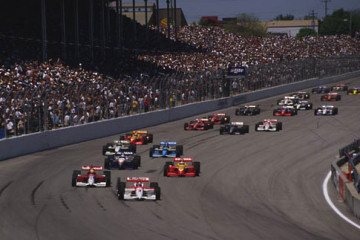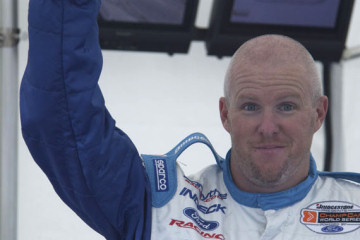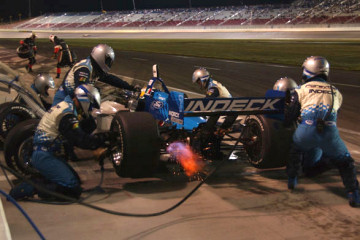Is there a future for Champ Car on ovals?
by Gordon Kirbyillustrated by Paul Webb

The drivers don't much like it and to my mind it's nothing like as spectacular as ten and twenty years ago when the drivers had get out of the throttle for the corners and sometimes use the brakes as well so there were substantial and exciting differences in performance making for breathtaking passing and racing.
The outside pass and the ability to work through traffic, sometimes at prodigious rates, like we've seen in the past from guys like Rick Mears, Tom Sneva, Al Unser Jr and Michael Andretti are almost lost arts, as well as lost spectacles, to the fan. Now the inside line is the fastest and shortest line. That is where most IRL races are won and it was certainly the quick, winning path at the Las Vegas Motor Speedway last Saturday night. The name of the game is to protect the inside line at all costs and to force your competitor high where it's all but impossible to inch by.
"We have the same power now that we ran when I started racing Champ cars in 1991," Paul Tracy pointed out. "I ran a Chevy that had 700 horsepower and we used to run 224 mph laps at Indianapolis and Michigan. Now fifteen years down the road with the same horsepower and we're running 200 mph laps.
"It's just so easy flat-out," Tracy added. "There's no driving talent at all. It has nothing to do with it. It's about engineering, aerodynamics and reducing the friction. It's got nothing to do with driving."
On this point, defending champion Bourdais agrees completely with Tracy.
"You need less downforce so you have to drive the car," Bourdais said. "You need something like a thousand pounds less downforce. Then you would really have to drive it. Sure, it would go a little faster on the straights but you would have to go slower in the corners. So it would just balance itself and at least you would be driving it.
"When it's flat like this you have to take big chances to make anything happen. It's just about how stupid you're willing to be. You need to lift for the corners. That's the way all racing is supposed to be."

"I can understand why fans are more attracted to NASCAR because there's a lot of separation," Tracy said. "At most tracks, a NASCAR car is not capable of going flat-out all the way around. They have to brake, slow-down and accelerate, and the tires go away. That makes the racing interesting because things are changing all the time. There are different rates of tire wear and different stategies develop. Because the cars are having to slow-down for the corners a lot of mixing up goes on."
As Bourdais says, the driver should have to lift, get out of the throttle and maybe use the brakes, before having to feed the power back on and drive the car through the corner while feeding on the power. Brake and throttle modulation are the essence of fine driving and I'll always remember talking with Rick Mears one evening at Mid-Ohio nine or ten years ago. We were bemoaning the arrival of traction control, illegal or not.
"This us my traction control right here," Rick remarked, gently waving his hand and curling his fingers as if they were his right foot. "This is the test for the driver. It's what it's all about."
This fine skill and aggressive ability are what separates the men from the boys, and today, it's been removed from open-wheel racing on high-banked oval tracks, as it has in NASCAR on the restrictor plate tracks, Daytona and Talladega.
As NASCAR great Fred Lorenzon said in a recent issue of NASCAR Scene: "My grandmother could drive around Talladega. That's not racing."
When the Daytona Speedway opened in 1959 the first and last Champ car race was run at the country's first high-banked superspeedway. Marshall Teague was killed in practice and George Amick was killed when he crashed on the last lap of the race and neither Bill France Sr nor Bill Jr would ever again run a USAC race at their track. Even then high-banked superspeedways were too fast, too dangerous for open-wheel cars.
As time went on Daytona was considered too fast for stock cars as well and in 1988 NASCAR introduced restrictor plates for Daytona and Talladega. The danger of restrictor plate racing of course, with massed packs of cars droning around together, is mutli-car accidents; "The Big One" feared by NASCAR and IRL drivers alike. In fact, we've seen these type of accidents in both NASCAR at Daytona and Talladega and in the IRL at many tracks.
The hard question is, has open-wheel racing run its course on oval tracks? How many more restrictions can you place on the cars when you really need to open-up the formula? The fact of the matter is the fear of a big accident is always there and we've already seen the results. Spectators in the grandstands have been killed at both IRL and CART oval races and many people worry about a day when a car flies into the grandstands at an oval track and kills more than a few people. Heaven forbid that it happens, but it's all too likely.
These days Champ Car runs just two oval races and neither pulls much of a crowd. The same is true of many IRL races. The California Speedway and Phoenix have decided to give up on the IRL because of weak and weakening crowds. It's sad to see this happen at places that used to fill the house. For many years Phoenix was a stronghold for Champ car racing while in the late nineties the California Speedway drew 100,000 to its 500-mile Champ car race.
"I don't think there's a future for open-wheel racing on ovals," says Paul Tracy. "The only future for ovals is cars that have got fenders on them because NASCAR specializes in marketing to the masses and neither the IRL nor Champ Car has the marketing dollars or the expertise or the time that they can afford to market the sport like NASCAR does. NASCAR is a marketing machine that specializes in marketing themselves to the masses."
Cristiano da Matta agrees with Tracy. "I don't think there's any future for racing these cars on ovals," da Matta says. "In my opinion the time has passed for oval tracks and open-wheel cars. A big thing is that even the fans who don't understand racing so much because they are not on the inside can see it because they don't come to watch because it's boring.
"I don't see any problem running a formula that is mainly road courses and street courses," da Matta adds. "We go to Milwaukee and there's nobody in the grandstands watching the race. We go to Las Vegas and it's the same. Instead, we're the support race for the Barber Dodge series of NASCAR. It doesn't make you feel very good."

A dozen years later the world of open-wheel oval track racing has been knocked upside down to the point where Champ Car races essentially as a support show in Las Vegas to NASCAR's truck series and the IRL's big draw is a rookie female driver.
Is this the right image or position for a supposedly major, first rate sport? I think not. Indeed, I often wonder what the likes of AAA heros Jimmy Murphy and Frank Lockhart and USAC stars Bill Vukovich, Tony Bettenhausen and Jimmy Bryan would have to say about this sad state of affairs. I'm sure it wouldn't be very complimentary.
In all, it's a very big conundrum, and I'm afraid the only solution come 2007 is to chalk it up to experience and move on, leaving oval racing sadly in the past.
Auto Racing ~ Gordon Kirby & Paul Webb ~ Words and Images
Copyright 2006 ~ All Rights Reserved
Copyright 2006 ~ All Rights Reserved
Top of Page